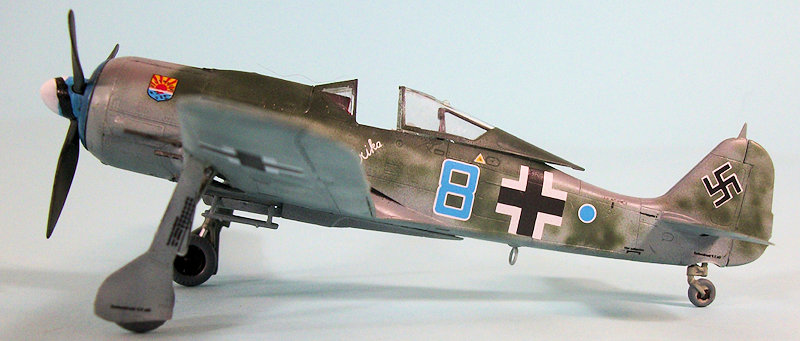
| KIT #: | 7011 |
| PRICE: | $24.95 SRP |
| DECALS: | Five options |
| REVIEWER: | Tom Cleaver |
| NOTES: | Profipack |

| HISTORY |
The Fw-190A-8 was the
most widely-produced sub-type of the early radial-engine Focke-Wulf fighters.
Appearing in 1943, it increased the armament from two 7.7mm machine guns in the
fuselage to two 13mm
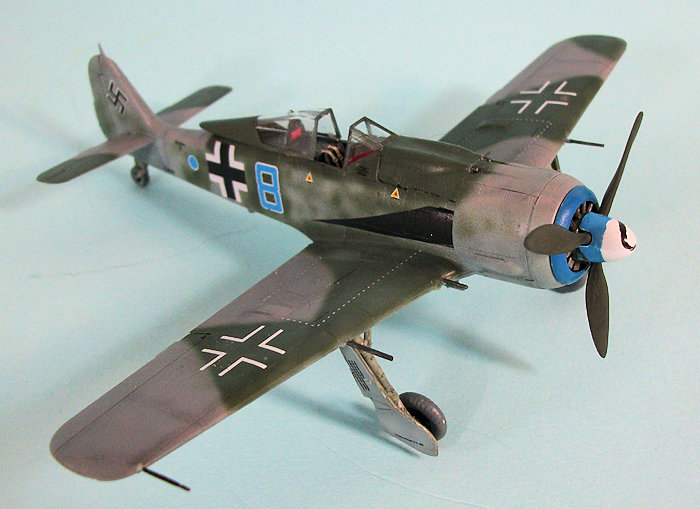 weapons, to increase its effectiveness as a bomber
destroyer. The additional weight reduced its effectiveness in air combat with
enemy fighters. The A-8 served until the end of the war.
weapons, to increase its effectiveness as a bomber
destroyer. The additional weight reduced its effectiveness in air combat with
enemy fighters. The A-8 served until the end of the war.
JG 5 “Eismeer”:
As the name “Eismeer” (Ice Sea) implies, the jagdgeschwader was created for operations in Norway and northern parts of Finland, under control of Luftflotte 5, and responsible for air defense of Norway. It was originally formed from I/JG 77 in 1942. Interestingly, 25 aircraft that once served with JG 5 still survive, more than from any other combat unit in the Luftwaffe of World War II.
By the fall of 1944, the unit was widely distributed, with III/JG 5 having been sent to France following the invasion. IV/JG 5 was based in southern Norway, where the unit was charged with air defense against the RAF coastal raids by the Banff Strike Wing.
| THE KIT |
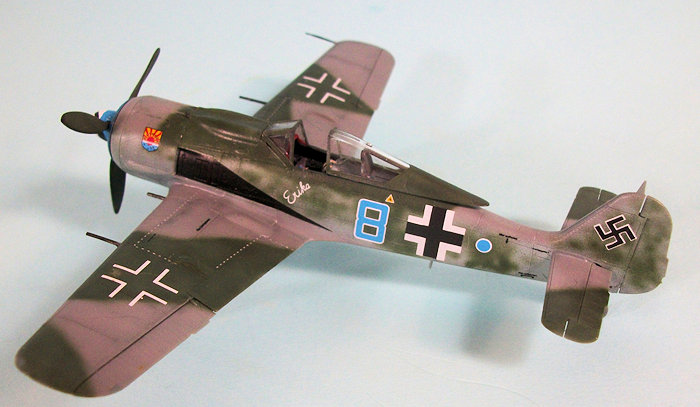 Eduard’s new 1/72
Fw-190A series kit first appeared in the fall of 2015. Unlike the 1/48 Butcher
Birds, the kit is be design the opposite of “fiddly.” Parts are included that
allow a modeler to create a Fw-190A-5, A-6 or A-7, with some modifications
needed. Eduard has already announced the release of an Fw-190A-5, which has the
proper cover for the MG-FF cannon cover on the lower wing.
Eduard’s new 1/72
Fw-190A series kit first appeared in the fall of 2015. Unlike the 1/48 Butcher
Birds, the kit is be design the opposite of “fiddly.” Parts are included that
allow a modeler to create a Fw-190A-5, A-6 or A-7, with some modifications
needed. Eduard has already announced the release of an Fw-190A-5, which has the
proper cover for the MG-FF cannon cover on the lower wing.
The kit includes a nicely-detailed cockpit. With the Profipack version this includes pre-painted photo-etch instrument panels and seat belts. The clear parts include the “flat” and “bulged” canopy, and also the “squeezed” open canopy for both versions, as does the 1/48 kits. The decal sheet provides markings for five different aircraft.
| CONSTRUCTION |
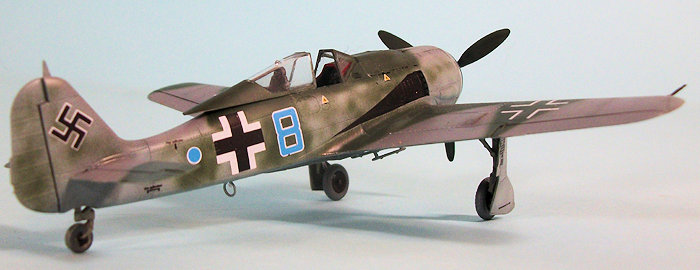 I began by
pre-painting the cockpit interior in RLM66 and the gear wells and landing gear
in RLM02, which I then covered with Tamiya “Smoke” to pop out detail. I also
pre-painted the engine. I assembled the cockpit and attached the photo-etch
instrument panel and side panels, and installed that in the fuselage. I
assembled the fuselage, then turned to the wings. I assembled the gear well and
then the wings, then attached that to the fuselage. After attaching the
horizontal stabilizer, the model was complete. All this took about 2-3 hours. I
left it overnight to set up fully.
I began by
pre-painting the cockpit interior in RLM66 and the gear wells and landing gear
in RLM02, which I then covered with Tamiya “Smoke” to pop out detail. I also
pre-painted the engine. I assembled the cockpit and attached the photo-etch
instrument panel and side panels, and installed that in the fuselage. I
assembled the fuselage, then turned to the wings. I assembled the gear well and
then the wings, then attached that to the fuselage. After attaching the
horizontal stabilizer, the model was complete. All this took about 2-3 hours. I
left it overnight to set up fully.
| COLORS & MARKINGS |
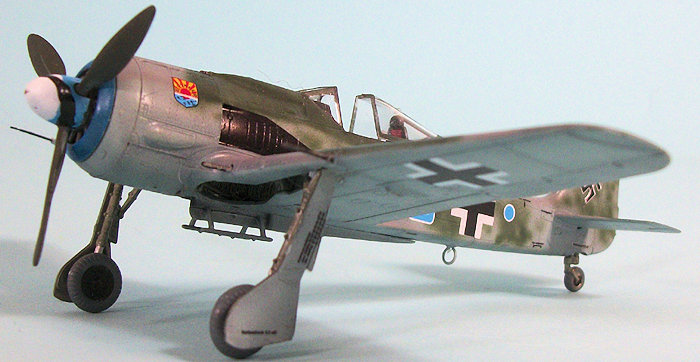 I decided to do the
airplane featured on the boxart, which comes from JG 5. I freehanded a standard
Fw-190 camouflage scheme of RLM 74/75/76, then hand-painted the armored cowling
ring with Tamiya “Sky Blue,” which matched the blue in the decals.
I decided to do the
airplane featured on the boxart, which comes from JG 5. I freehanded a standard
Fw-190 camouflage scheme of RLM 74/75/76, then hand-painted the armored cowling
ring with Tamiya “Sky Blue,” which matched the blue in the decals.
The Eduard decals went on without problem under a coat of Micro-Sol. All of the standard stenciling is provided and was used.
I gave the model an overall coat of clear flat varnish, then unmasked the canopy and attached the landing gear and prop. The sliding canopy was attached in the open position.
| CONCLUSIONS |
I haven’t built a 1/72 Fw-190 since doing Hasegawa’s then-nice kit 40 years ago. That kit is still nice; having looked at the 1/72 kits released by Airfix and Academy, I think it is safe to say that this Eduard kit is the best 1/72 radial-engine Fw-190 kit out there. The surface detail is petite, assembly is a breeze. Highly recommended to any modeler.
March 2016
Copyright ModelingMadness.com Review kit courtesy
of a check from my publisher. If you would like your product reviewed fairly and fairly quickly, please
contact the editor
or see other details in the
Note to
Contributors.